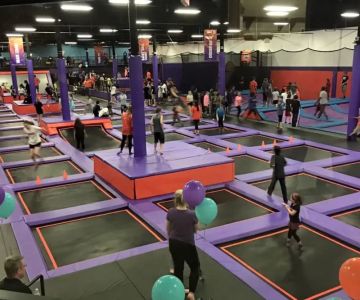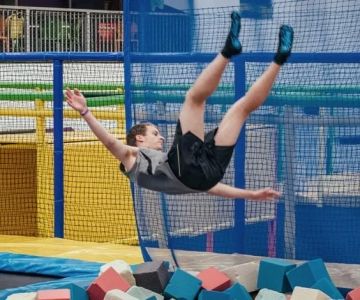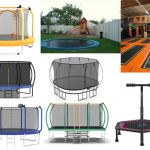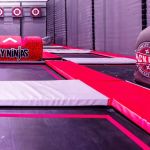- 1-Preparing-for-a-Trampoline-Trick-Show
- 2-Building-a-Strong-Foundation
- 3-Advanced-Techniques-and-Safety
- 4-Mental-and-Physical-Preparation
- 5-Real-Life-Examples-and-Inspiration
- 6-Where-to-Find-the-Best-Trampoline-Gear
1. Preparing for a Trampoline Trick Show
Training for a trampoline trick show requires more than just bouncing around—it demands focused preparation, dedication, and understanding the unique demands of performing high-level tricks safely. Before even attempting complex maneuvers, it's essential to familiarize yourself with the trampoline and basic jumping techniques. This foundation is crucial because trampoline tricks rely heavily on body control, timing, and spatial awareness.
Starting with simple jumps and controlled landings can build confidence and help prevent injuries. Many performers recommend setting clear training goals, such as mastering specific tricks step-by-step, to track progress and stay motivated. This kind of structured preparation will lay the groundwork for more complex routines that impress audiences during a show.
1.1 Understanding the Equipment
The trampoline itself is more than just a springy surface—knowing its dimensions, tension, and how it reacts to different jumps can dramatically improve your performance. Investing time in learning about the trampoline's properties will allow you to maximize airtime and control. Additionally, understanding the safety features and padding is vital to protect yourself during intense practice sessions.
2. Building a Strong Foundation
Every great trampoline trick show performer starts by mastering the basics. The initial training phase should focus on building strength, flexibility, and basic jump techniques. Incorporating exercises off the trampoline—like core workouts, balance drills, and plyometrics—can significantly enhance your control during tricks.
One effective training routine includes:
- Practicing straight jumps and seat drops to perfect balance and timing.
- Learning to maintain body posture mid-air to prepare for flips and twists.
- Gradually introducing simple tricks such as tuck jumps or pike jumps, which build muscle memory.
Consistency is key. Regularly practicing these fundamentals helps build muscle memory and reduces the risk of injury. For example, a well-known trampoline coach emphasizes that beginners should dedicate at least 4 to 5 weeks to foundational training before moving on to advanced tricks.
2.1 Strength and Conditioning
Besides trampoline practice, strengthening your legs, core, and arms ensures better power and stability. Exercises like squats, lunges, and planks improve the muscles involved in jumping and landing. This physical conditioning not only boosts performance but also prevents injuries caused by improper technique.
3. Advanced Techniques and Safety
Once a solid foundation is in place, training can shift toward more complex tricks such as flips, twists, and combinations that captivate audiences in a trampoline trick show. However, advancing your skills must always be balanced with safety precautions.
Using spotters, safety nets, and mats during training sessions minimizes injury risk. Professional performers often recommend training with experienced coaches who can provide feedback and guidance on form and technique. Video analysis is another useful tool, allowing you to see and correct mistakes in your routine.
3.1 Progressing Through Difficult Tricks
Trampoline trick progression typically follows a stepwise approach. For example, a backflip might start with learning backward rolls on the floor, then progressing to assisted backflips on the trampoline before attempting solo jumps. This gradual progression reduces fear and builds the necessary strength and coordination.
3.2 Common Safety Practices
Wearing proper attire, including fitted clothing and non-slip socks or bare feet, helps maintain grip and movement freedom. Always warm up thoroughly and cool down after training to prevent muscle strain. Avoid overtraining by allowing your body adequate rest to recover from intense sessions.
4. Mental and Physical Preparation
Beyond physical skills, mental preparation plays a crucial role in delivering a standout trampoline trick show. Visualizing routines, practicing breathing techniques to stay calm, and building confidence through gradual skill mastery can reduce performance anxiety.
Many elite performers use mental rehearsal as part of their daily training. For example, imagining a successful routine multiple times helps the brain prepare for real execution. Additionally, maintaining a healthy diet and proper hydration supports energy levels and focus during training and shows.
4.1 Overcoming Fear and Building Confidence
Fear of injury or failure is common among trampoline athletes, especially when learning new tricks. Developing confidence requires patience and acknowledging progress, no matter how small. Surrounding yourself with a supportive training community can boost motivation and accountability.
5. Real-Life Examples and Inspiration
One inspiring story comes from Emily, a young trampoline enthusiast who trained for six months before joining a local trampoline trick show. Emily’s journey highlights the importance of patience and structured training. She started with basic jumps, progressed through a disciplined strength regimen, and gradually mastered aerial flips under her coach’s guidance. Her debut performance was met with applause, proving that dedication pays off.
Similarly, the rise of trampoline sport in recent Olympic Games has fueled interest worldwide. Watching professionals like Rosie MacLennan demonstrates how intricate tricks and flawless execution can wow crowds and elevate the art of trampoline performance.
6. Where to Find the Best Trampoline Gear
For anyone serious about training for a trampoline trick show, having the right equipment is essential. Trampoline Zone offers a wide selection of trampolines, safety gear, and training accessories tailored to all skill levels. Whether you are a beginner or a seasoned performer, you can find products designed to enhance your training experience and safety.
From durable mats to adjustable trampolines and professional coaching tools, investing in quality gear supports long-term progress and enjoyment. Exploring options at Trampoline Zone will ensure you have everything needed to train effectively and perform confidently.







 Zap Zone XL4.0 (2483 reviews)
Zap Zone XL4.0 (2483 reviews) We Rock the Spectrum - Northeast Philly4.0 (190 reviews)
We Rock the Spectrum - Northeast Philly4.0 (190 reviews) Westbank Village Shopping Center4.0 (539 reviews)
Westbank Village Shopping Center4.0 (539 reviews) Super Sky High Bungee5.0 (1 reviews)
Super Sky High Bungee5.0 (1 reviews) Boomers Santa Maria4.0 (1904 reviews)
Boomers Santa Maria4.0 (1904 reviews) Get Air Pickerington4.0 (651 reviews)
Get Air Pickerington4.0 (651 reviews) Are Trampoline Parks Safe for Kids? Essential Guide for U.S. Parents
Are Trampoline Parks Safe for Kids? Essential Guide for U.S. Parents How Often Should You Replace Trampoline Springs? Tips for Proper Maintenance
How Often Should You Replace Trampoline Springs? Tips for Proper Maintenance How Much Is a Trampoline? A Detailed Guide to Trampoline Costs and Buying Tips
How Much Is a Trampoline? A Detailed Guide to Trampoline Costs and Buying Tips Bounce Techniques for Stronger Legs: Effective Exercises and Tips
Bounce Techniques for Stronger Legs: Effective Exercises and Tips Essential Music Gear for Trampoline Dance: Complete Guide
Essential Music Gear for Trampoline Dance: Complete Guide Fun STEM Experiments Using Trampolines to Spark Curiosity and Learning
Fun STEM Experiments Using Trampolines to Spark Curiosity and Learning